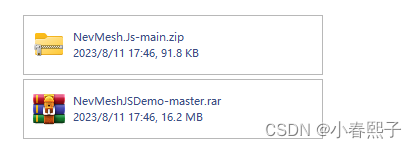Laya游戏开发中AI寻路解决方案
发布时间:2024年01月04日
1.AI自动寻路:
机器人代码重构,按照目标点去执行逻辑,提前几帧判断直线,非直线的情况下,预设转弯角度,角度判断到达直线后开始执行到目标点的逻辑
2.U3D布点寻路
3.NevMesh.Js寻路插件
NevMesh.Js你可以在Laya引擎中直接使用的AI寻路 - 简书
Demo演示:www.layabox.com

(1)U3D中使用NavMesh寻路系统,对障碍物就行烘焙,也就是对场景中的物体进行标记,然后烘焙路径,产生网格数据;为需要进行寻路的物体添加寻路组件NavMeshAgent,通过NavMeshAgent组件的属性或方法进行移动

选中场景中所有障碍物和地面对象,勾选Navigation Static

(2)cs文件拖入U3D项目中:

然后 LayaAir3D中出现NavMesh导出, 然后会在工程目录生成一个ExportNavMesh文件夹,里面的文件就是导出的NavMesh模型obj文件


(3) 这时候需要将导出的obj文件利用转换工具转换成json格式的文件,让Laya读取

运行转化代码:
python convert_obj_three.py -i testScene.obj -o out.json
(4)项目使用的脚本,将NevMesh.js放到项目bin/libs文件夹中,将NevMesh.d.ts放到项目libs文件夹中,在bin/index.js中增加loadLib("libs/NevMesh.js"),注意需在loadLib("js/bundle.js");前面

loadLib("libs/NevMesh.js")
//-----libs-end-------
loadLib("js/bundle.js");(5)加载导出的.json文件
this.navUrl="meshes/outfile.json";
Laya.loader.load(this.navUrl,Laya.Handler.create(this,this.onNavLoaded),null,"json");
onNavLoaded(){
var json=Laya.loader.getRes(this.navUrl);
let zoneNodes = NevMesh.buildNodesByJson(json);
NevMesh.setZoneData('game',zoneNodes);
this.playerNavMeshGroup = NevMesh.getGroup('game', this.player.transform.position);
}(6)初始化寻路对象:
this.player=sceneLoad.getChildByName("player");
this.physicsSimulation=sceneLoad.physicsSimulation; //物理模拟器
this.agent=null;
this.agent=this.player.addComponent(NavMeshAgent);
this.agent.speed=10;
(7)鼠标点击目标位置点,射线检测,开始寻路:
//创建射线
this.ray=new Laya.Ray(new Laya.Vector3(),new Laya.Vector3());
//射线检测结果
this.hitResult=new Laya.HitResult(); this.camera.viewportPointToRay(new Laya.Vector2(Laya.stage.mouseX,Laya.stage.mouseY),this.ray);
if(this.physicsSimulation.rayCast(this.ray,this.hitResult)){
console.log("000");
this.targetPos=this.hitResult.point;
let calculatedPath = NevMesh.findPath(this.player.transform.position,this.targetPos, 'game',this.playerNavMeshGroup);
if (calculatedPath && calculatedPath.length){
var debugPath=(calculatedPath);
console.log("start",this.player.transform.position.x,this.player.transform.position.y,this.player.transform.position.z);
var p=[];
for (var i=0;i < debugPath.length;i++){
console.log(debugPath[i].x,debugPath[i].y,debugPath[i].z);
p.push(new Laya.Vector3(debugPath[i].x,debugPath[i].y+.1,debugPath[i].z));
}
this.agent.path=[this.player.transform.position].concat(p);
this.agent.enabled=true;
console.log("end",this.targetPos.x,this.targetPos.y,this.targetPos.z);
}
else{
this.agent.enabled=false;
}
}
文章来源:https://blog.csdn.net/woshiyuyanjia/article/details/135380058
本文来自互联网用户投稿,该文观点仅代表作者本人,不代表本站立场。本站仅提供信息存储空间服务,不拥有所有权,不承担相关法律责任。 如若内容造成侵权/违法违规/事实不符,请联系我的编程经验分享网邮箱:chenni525@qq.com进行投诉反馈,一经查实,立即删除!
本文来自互联网用户投稿,该文观点仅代表作者本人,不代表本站立场。本站仅提供信息存储空间服务,不拥有所有权,不承担相关法律责任。 如若内容造成侵权/违法违规/事实不符,请联系我的编程经验分享网邮箱:chenni525@qq.com进行投诉反馈,一经查实,立即删除!
最新文章
- Python教程
- 深入理解 MySQL 中的 HAVING 关键字和聚合函数
- Qt之QChar编码(1)
- MyBatis入门基础篇
- 用Python脚本实现FFmpeg批量转换
- MBP的新拉力=800MT+凯越525+泛美?
- 计算机毕业设计------JSP校园运动会管理系统
- Java利用TCP实现简单的双人聊天
- 第三篇 结构型设计模式 - 简化复杂系统的结构
- JS: 与数组 Array 相关的方法
- 【issue-halcon例程学习】fuzzy_measure_pin.hdev
- 面试算法117:相似的字符串
- C++ 函数对象
- Hadoop3.3.5云服务器安装教程-单机/伪分布式配置
- 适用于 Windows 11 的前 5 名数据恢复软件